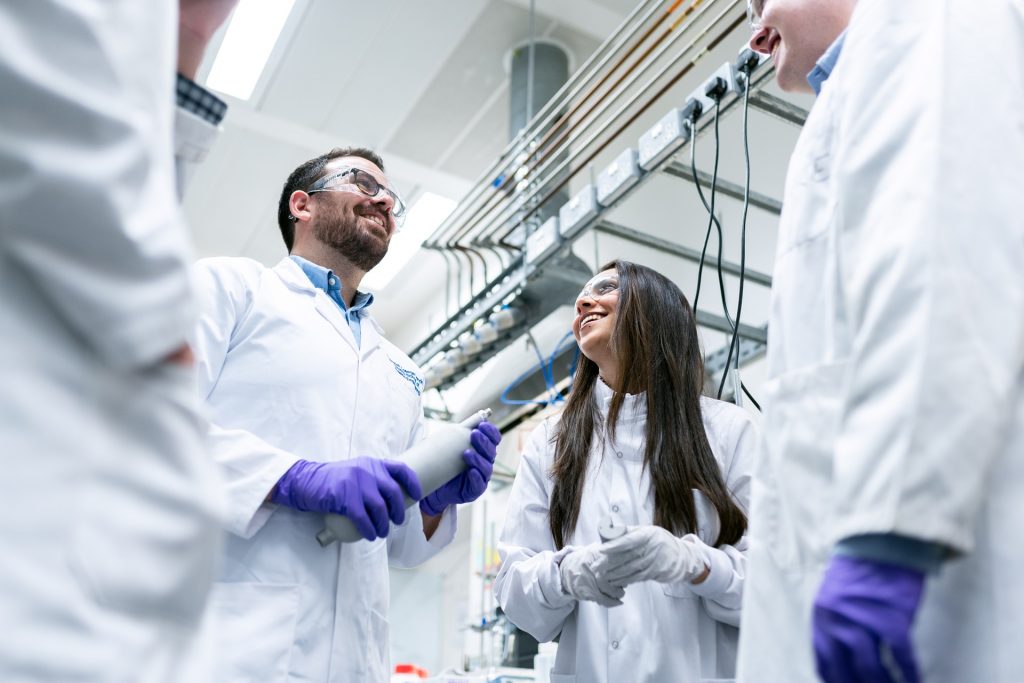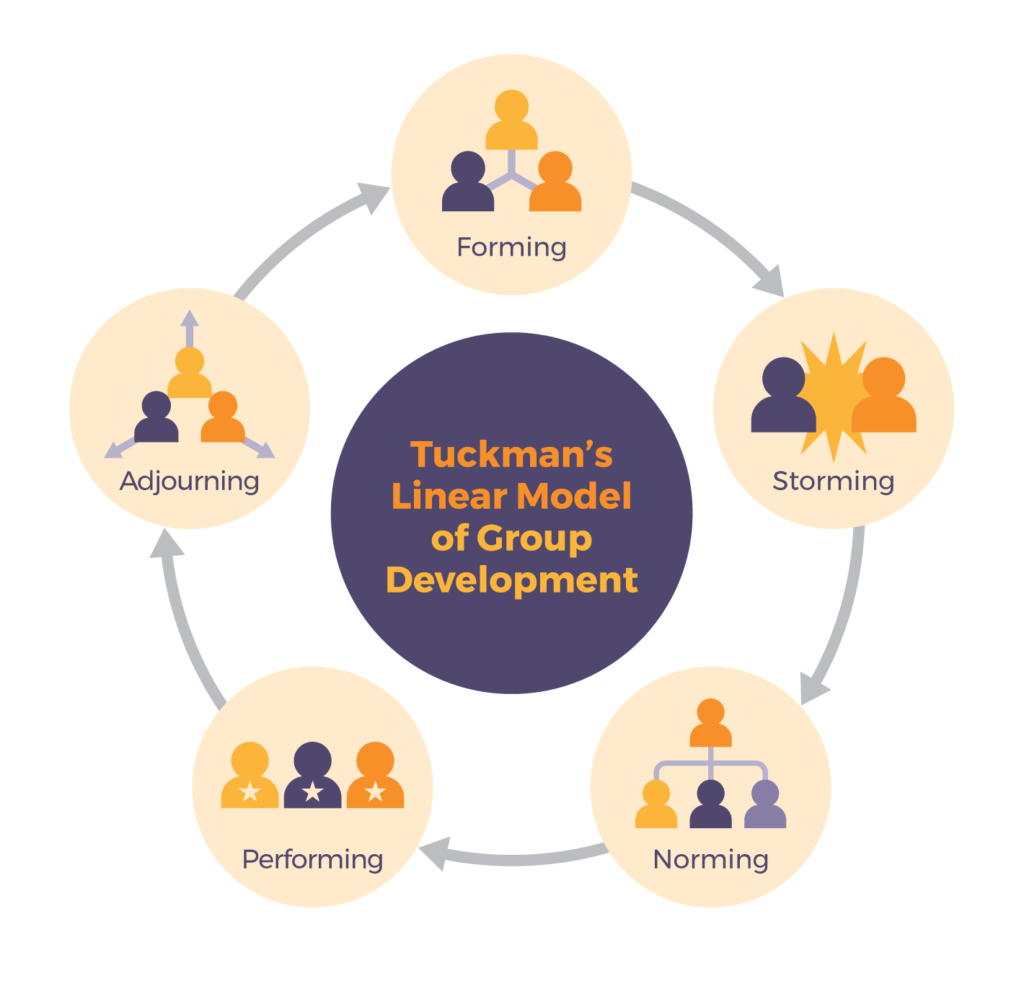26 Collaboration
Reading time: 7 minutes
Overview
Science rarely occurs in a vacuum (metaphorically, of course). Throughout your scientific career, and beyond, you will need to collaborate with others to achieve the best science. This chapter briefly provides communication skills for teamwork and collaboration in research.
Sections in this chapter

The power of a team
It is widely accepted that cooperative teams have greater efficiency and give better results than working alone. Why, then, are some people reluctant to engage in teamwork? Perhaps this reluctance stems from ineffective or dysfunctional teamwork experiences in the past. Often the culprit in these situations is not a “poor team player” or an “inability to get along with others.” More likely it was caused by one of two things: misaligned goals or confusion over roles. For teamwork to be effective, all members of the team must understand and share the goals of the project, and all members must fully understand their roles—what is expected of them, and how they will be held accountable. An effective team leader will make sure that goals and roles are fully understood by all team members.
“Introduction to Teamwork,” a section in Designing Engineers, by Susan McCahan et al.[1] provides a detailed description of the stages of the Tuckman Model of Team Development (Figure 26.1) and the need for effective communications at each stage.[2] A team, according to McCahan et al., “is a group of people who come together to work in an interrelated manner towards a common goal.” They go on to differentiate a team from a group by noting that a team is connected by “a common purpose or goal and the reliance on the skills of all the members to meet the goal”. In other words, team members see themselves as part of a collective working towards a common goal rather than individuals working on separate tasks that may lead to an end product. In order to work effectively, team members need to communicate clearly and constructively and learn how to deal with crises and conflicts that will inevitably arise.

EXERCISE: Reflect on your previous teamwork experience
Think of a time when you had to work with others to produce something – a poster, presentation, document, etc. Briefly describe what the task was and then consider the following questions:
- What was the team’s overall goal?
- What was your job within the group?
- How were the jobs distributed?
- How well did your group function? Did anyone on the team behave in ways that McCahan et al. characterize as “hitchhikers, hijackers, isolationists, and enablers”?[3]
- Was the outcome successful?
- Would you happily work with those teammates again on another project? Why or why not?
- How would you rate your overall experience and why?
Team management
Some common benefits of working in teams include increased productivity, increased innovation, and increased efficiency. Excellent teams have a synergy that makes them more than simply the sum of their parts. The term “team intelligence” refers to the fact that collectively, teams have more knowledge and skill than the single individuals working separately. However, challenges can also arise when working in a team. Conflicts within a team do occur and often they begin as a result of poor communication and weak focus. Some ways to handle these challenges include the following:
- Elect a team leader: the team leader will act as the hub for communication and tasks and provide direction and guidance for the team. This should be someone who has earned the team’s respect and who can be persuasive and tactful.
- Ensure the goal is clear: a team is governed by the goal that everyone works to achieve. It is important that the goal is clearly understood and agreed upon by everyone on the team.
- Establish team rules: as a team, determine the rules by which the team will operate. These should include expectations around time, meetings, attendance, communication, decision-making, contribution, and mechanisms to warn and/or fire a team member or quit a team.
- Assign responsibilities: as part of the breakdown of tasks, members should be assigned responsibility for certain tasks, which means that they are the primary leads in preventing and addressing issues that come up in that area.
- Set agendas for meetings and keep minutes: to ensure that team meeting time is useful and achieves its purpose, plan an agenda for each meeting to help keep everyone on task. In addition, have someone take minutes to record decisions that are made. This record helps prevent repetition and ensures work actually gets done.
- Determine the timing for tasks: task timing involves two aspects: the duration for completing the task and the timing of the task in relation to the other tasks. Typically, tasks take longer than you think they will so it is often better to add 25% to your duration estimate. Professionals often use Gantt Charts to outline these tasks and the time they will take within the overall project scale.
- Manage communications: if a problem arises with someone on the team, the team leader should speak privately to the person and clearly indicate what needs to change and why. The focus should be on the behaviour, not on the person’s character. Issues should be dealt with quickly rather than left to deteriorate further. If this does not solve the problem, seek help from experts in conflict resolution.
- Use tools to collaborate. There are also many software programs and apps that can help teams manage projects. Students often use Google docs to work collaboratively on a document or project. Slack, Teams, and Asana are free popular web-based options for task management. Whatever tool you choose to use, it should be something that all members can access and understand.
Meeting Documents: Agendas and Minutes
What happens at team meetings should be planned and recorded for future reference. Agendas and Minutes are documents that do this. A meeting also should have a chair (the person who keeps things on track) and a recorder (who records what happened and what decisions were made). The Agenda is the plan for what you want to discuss and accomplish at the meeting. It is usually made up of a list of items, sometimes with a time frame for each item.
Example Agenda
CHEM 282 Team Meeting Agenda
Date:
Place and time:
Members:
—————————————————-
- Updates from each team member (progress) (5 min each)
- Develop work plan for upcoming week (15 min)
- Determine next meeting time (5 min)
- Work on Milestone 3 together (45 min)
- Matters arising
Minutes follow up on the agenda by recording what decisions were made and what important topics were discussed. One person is responsible for recording the events of the meeting and distributing the minutes to each member (via email usually). That way, no one should forget what tasks they agreed to complete and when.
Example Minutes
Biochemistry Labs Team Meeting Minutes
Thursday, Feb 15, 2016
Room 205, 3:30-4:45
Present: Jaime, Chris, Renee
Regrets: Joe (has the flu)
—————————————————-
- All team members have completed last week’s work plan (Joe emailed a report, as she is sick)
- In the coming week, we plan to complete the following:
Task Who will do it? 1. Interview Facilities Management contact Renee 2. Research instrument optons (Joe?) 3. Design a survey/questionnaire Chris 4. Do a site visit Jaime
- Next meeting: next Thursday, Feb 21, after seminar
- Excellent progress during the meeting; Joe will follow up on researching instrument options
- Meeting adjourned 4:50
Collaborative Writing
You have likely had at least one opportunity to work and write collaboratively with others, as this is an increasingly common way to work, both in school and in the workplace. Scientists and engineers work collaboratively to gather, organize, manage and disseminate information. This information is often carefully analyzed and used to make important decisions, so it is critical that team members collaborate effectively in managing these communications tasks.
Like any kind of teamwork, collaborative writing requires the entire team to be focused on a common objective; according to Lowry et al., an effective team “negotiates, coordinates, and communicates during the creation of a common document.”[3] The collaborative writing process is iterative and social, meaning the team works together and moves back and forth throughout the process.
Collaborative writing using computers, until recently, was nothing short of a nightmare. Working together on a document could cause file conflicts, deletions, and extra work to find out what changes were made. Now, if you have the right set-up, multiple people can edit a document at the same time without file conflicts (e.g., in Google Docs or Teams). Alternatively, there are systems for “checking out” files, so that they cannot be opened and edited by more than one person at once. With file versioning in Microsoft Office 365, it’s now easier to keep old versions of documents without having to save a new draft each time you make changes.
Attribution
This chapter was adapted from Technical Writing Essentials by Suzan Last and Candice Neveu which is licensed under a Creative Commons Attribution 4.0 International License.
- S. McCahan, P. Anderson, M. Kortschot, P. E. Weiss, and K. A. Woodhouse, “Introduction to teamwork,” in Designing Engineers: An Introductory Text, Hoboken, NJ: Wiley, 2015, pp. 219-246. ↵
- eCampus Ontario. “Tuckman’s Linear Model of group development”, in Communication for Business Professionals - Canadian Edition [Online]. eCampus Ontario, 2018. Available: https://ecampusontario.pressbooks.pub/commbusprofcdn/. CC-BY-SA. ↵
- P.B. Lowry, A. Curtis, and M.R. Lowry, “Building a taxonomy and nomenclature of collaborative writing to improve interdisciplinary research and practice,” Journal of Business Communication, vol. 41, 2004, pp. 66-97. DOI: https://doi.org/10.1177/0021943603259363 ↵

